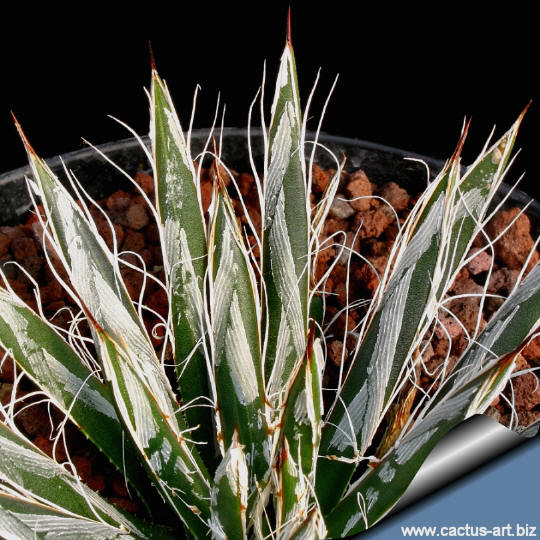|
|
|
Family: Agavaceae
Scientific name:
Agave toumeyana var. bella
Breitung
Pubblished in: Cact. Succ. J. (Los
Angeles). 32: 81, fig. 41. 1960
Origin:
Central
Arizona (USA) restricted to the eastern slope of the Bradshaw Mountains,
eastern Yavapai to northwestern and central to southern Gila County,
northeastern Maricopa to northern Pinal County.
Habitat: Occurs in rocky hillsides, highland desert mesas,
chapparal, or lower pine forest on open gravelly to rocky limestone or basalt
slopes, mostly with desert scrub, chaparral, and pinyon juniper
woodlands; 800 1700 m;
Conservation status: Listed in
CITES appendix 2.
Common Names include: Toumey agave, Miniature Century Plant, Fairy-ring agave,
Silver Dollar, Agave
Synonyms:
- Agave toumeyana ssp. bella (Breitung)
Gentry
|
|
|
|

The leaves are thin, stiff with striking white markings and adorned with
curling white threads giving the small rosettes an appealing tidy
appearance
The variety "bella" is much smaller
and compact than the typical Agave toumeyana (up to 20 cm
tall). It has shorter, more equal, leaves with margins replaced by
denticles in the lower ½ of the leaf and makes a denser rosette.
It also make smaller inflorescence.
Description: Small rosettes, up to 20 cm in diameter, 25 cm tall,
each with 100–200 leaves at maturity Individual rosettes are small and
compact, but plants sucker readily forming large clumps.
Leaves: 9 to 20 cm long, 0.6 to 2 cm wide of equal length giving the
rosette a flat-topped appearance, light to dark green, flat-topped, with
striking white markings.
Leaf margins are smooth with a brown border and white threadlike curling white threads,
replaced by
denticulate margins below 1/3 of leaf. The white filaments on the leaf
edges curl to resemble tight ringlets. When it gets watered on, the
filaments immediately partly uncurl, but as they dry out they slowly
re-curl again.
Apical spine: Subulate, with a short narrow groove above, 1(-2)cm long,
brown to greysh.
Flowers: The slender flower stalk (spike) is smaller ( 1.5 m tall) than in
the typical variety with densely or laxly flowers in the upper ½-¼ part, pale greenish yellow flowers 1.6–2.1 cm; limb
lobes 6.5–7 mm; filaments 1.1–1.3 cm.
Flowering time: Late spring to early summer. Remarks: The species suggest a larger version
of
A. parviflora with more acuminate leaves, larger flowers with
filaments inserted higher up in the tube.
Cultivation: Agave
toumeyana bella is a very cold hardy form of the species.
It is theoretically hardy to -12°C (or more) particularly
when dry. It is a
relative easy-to-grow species. Need a very well-drained, soil.
It grows fairly fast in summer if provided with copious water but
allows to dry thoroughly before watering again. During the winter
months, one should only water enough to keep the leaves from
shrivelling. They do well in full sun or a lightly shaded area. Plants
cultivated outdoors are drought tolerant and takes blasting heat and
full sun. It is a wonderful companion plant for Echinocereus and Escobaria cacti
species. Propagation: By
suckers which often are found growing around the base of the
plant, Remove the basal suckers (if available) in spring or summer
and let the cuttings dry for a few days before inserting in compost or
by seed.

 |
|